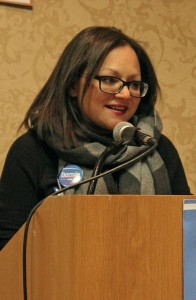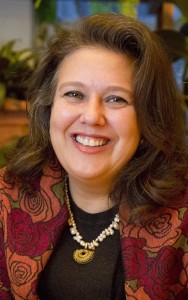Proviso schools ponder “safe zone” in response to ICE immigration raids
Jean Lotus — March 21, 2016A series of recent immigration raids in Stone Park and other Cook County towns in the past few months has made parents fearful of sending their children to school, an immigration lawyer told a group of educators at Proviso Math and Science Academy in Maywood on March 3.
“There’s a huge amount of fear in the community right now,” Mony Ruiz-Velasco told teachers, board members and administrators.
“Hundreds of families have been detained since the beginning of the year,” Ruiz-Velasco said. “ICE (Immigration and Customs Enforcement) officers work in unmarked cars and pretty much don’t have warrants. They knock on people’s doors and say it’s the police, and when people open up, ICE comes in,” she said. She added 235,000 people were deported or detained in 2015 nationwide.
“Even though ICE said they’re going after criminals, only about 3 percent of those detained have a criminal record.”
Board member Theresa Kelly wondered whether the district’s truancy rate was being affected by students staying home.
Detainees are processed at a federal center in Broadview, at 1930 Beach St., and then sent by bus to one of seven Illinois detention centers, Ruiz-Velasco said.
The Proviso Township High School District 209 is partnering with Melrose Park community group P.A.S.O. (Proyecto de Accion de los Suburbios Oestos or West Suburban Action Project) to work out how to create a high school “safe zone” for immigrant students and parents. School districts across the country are reacting to increased raids, which have nabbed Central American immigrants fleeing violence in El Salvador, Honduras and Guatemala.
In February, the Los Angeles Unified School District board proclaimed the district a safe zone and published a list of resolutions, including that they would not permit ICE officers on the property of the district’s 1,200 schools for raids without permission.
“I hear the vitriol and hate that is part of the political dialogue on TV and radio waves literally every morning, noon and night,” said Steve Zimmer, president of the LAUSD school board. “It is creating anxiety with students, parents, families and school communities.”
The LAUSD student body is about 74 percent Latino and 10 percent of the general population is undocumented, the school board said in a statement on its website.
Proviso’s student body is almost 40 percent Hispanic. No information is available about how many students are undocumented or who are the children of undocumented parents.
District 209 school board member Claudia Medina suggested to the school board March 8 that the district issue a similar proclamation to show support for high school students and their families.
Ruiz-Velasco said the district could help parents and students if they create an atmosphere of trust.
“Unfortunately, to a lot of immigrant parents, schools are seen as an extension of the government,” she said.
Already the district is planning information-sharing events. The schools will work with P.A.S.O. to let students and parents know about a special program just for undocumented teens and young adults who were brought to the United States as children. The Deferred Action for Childhood Arrivals (DACA) program allows students between 15 and 31 to apply for a special status that allows them to work for two years and receive a Social Security number. For many, this is a path to college because they become eligible for state aid. The program is renewable.
DACA does not change the person’s immigration status and it is not a green card, but it identifies the student as a person who is on a lower priority for deportation.
“People who are turning 15 are now eligible for the first time,” said Medina.
The DACA application process involves proving the student arrived in the U.S. under age 16 between June 2007 and 2012. Applicants must be in school, a graduate, GED or have been in the armed forces. They cannot have been convicted of a felony.
The application also costs $465.
In April, the district is planning a DACA information session with volunteer immigration lawyers who can help determine if they are eligible. The session will be open to residents of the county. They will then host a follow-up session in May where students who are eligible and have the correct paperwork can be assisted with filling out the forms.
“The more schools talk about undocumented families and make them feel welcome the more likely families will come forward for information,” Ruiz-Velasco said.
— Proviso schools ponder “safe zone” in response to ICE immigration raids —









